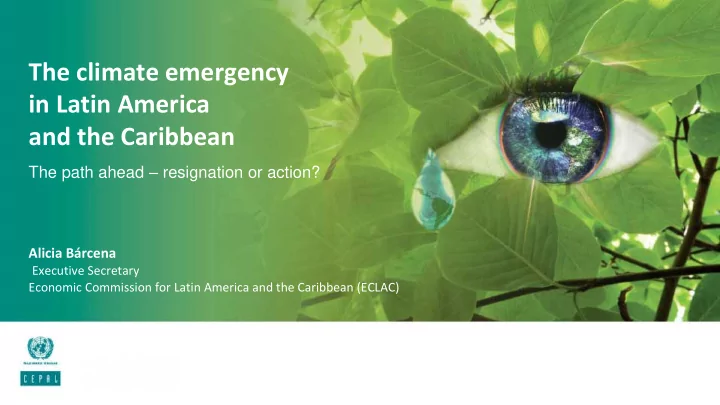

The climate emergency in Latin America and the Caribbean The path ahead – resignation or action? Alicia Bárcena Executive Secretary Economic Commission for Latin America and the Caribbean (ECLAC)
ECONOMIC COST AND IMPACT OF CLIMATE CHANGE The estimated costs associated with the main physical impacts of a 2.5 ° C temperature rise range between 1% and 5% of the region’s GDP. Between 1970 and 2019, Latin America and the Caribbean was hit by 2,309 disasters, according to figures from CRED. These events caused 510,204 deaths, and losses and damages affecting 297 million people and costing over US$ 437 billion. Highly sensitive sectors include agriculture (6% of regional GDP), in addition to the water challenge due to increased droughts, health effects and a high impact in coastal areas. The region is home to 8 of the world’s 17 megadiverse countries, located in the Andes-Amazon basin and in Mesoamerica but shows a decrease of 89% in the abundance of species populations since 1970, the most dramatic loss in any biogeographical world area. It is expected to decline by 13% during this century because of land use change High vulnerability of Central America and the Caribbean.
The adverse effects of climate change on the economy may occur within less than 10 years Latin America and the Caribbean (26 countries): projected variation in per capita GDP due to temperature rise, not including the cost of natural disasters, 2030 and 2050 (Percentages) Per capita GDP loss comparing inertial per capita GDP with the most pessimistic scenario for temperature rise by the end of the century (4 o C) Source : Figure II.5 in A. Bárcena and others, The climate emergency in Latin America and the Caribbean: The path ahead – resignation or action?, ECLAC Books, No. 160 (LC/PUB.2019/23-P), Santiago, Economic Commission for Latin America and the Caribbean (ECLAC), 2020.
Caribbean cities: close to the sea in most cases, with a large proportion of the population living at elevations of below 5 metres The he Car arib ibbea ean : land area below 5 metres, and percentage of population The Caribbean: urban coastline inhabiting areas below 5 metres (Kilometres) (Percentages) Source : M. Mycoo y M. Donovan, A Blue Urban Agenda: Adapting to Climate Change in the Coastal Cities of Caribbean and Source : United Nations Human Settlements Programmes (UN-Habitat), Urbanization and Climate Change in Small Island Pacific Small Island Developing States, Washington. D.C., Banco Interamericano de Desarrollo (BID), 2017. Developing States , Nairobi, 2015.
Sector drivers of structural change Non-conventional renewable energy Latin America and the Caribbean and the world: sectoral shares of greenhouse gas emissions, 2016 (Percentages) Nature-based solutions 80.0 70.4 Circular economy and recycling 70.0 60.0 Smart cities: digitization, sustainable 50.0 45.3 buildings and e-mobility 40.0 Sustainable, resilient infrastructure: 30.0 22.9 basic amenities 19.3 20.0 11.6 Less polluting consumption 8.6 7.2 10.0 5.8 4.9 3.3 0.3 0.3 0.0 Care economy Energy Agriculture and Industrial processes Land-use change Waste Other livestock and forestry World Latin America and the Caribbean Source: Figure I.5 in A. Bárcena and others, The climate emergency in Latin America and the Caribbean: The path ahead – resignation or action? , ECLAC Books, No. 160 (LC/PUB.2019/23-P), Santiago, Economic Commission for Latin America and the Caribbean (ECLAC), 2020.
Technological innovation makes renewable energy more economical, despite the undue advantages still enjoyed by fossil fuels Latin America and the Caribbean (12 countries): average normalized cost of solar and wind energy, 2018 (Dollars per kWh) Source: Figure V.17 in A. Bárcena and others, The climate emergency in Latin America and the Caribbean: The path ahead – resignation or action? , ECLAC Books, No. 160 (LC/PUB.2019/23-P), Santiago, Economic Commission for Latin America and the Caribbean (ECLAC), 2020. .
Generation of clean energy: growth and employment Brazil, Mexico and rest of Latin America and the Caribbean: net job Chile: contribution of each GWh generated to GDP, by technology, 2016 creation in an energy transition scenario, 2020 – 2030 (Thousands of jobs created) Source: Figure V.19 and Table V.17 in A. Bárcena and others, The climate emergency in Latin America and the Caribbean: The path ahead – resignation or action? , ECLAC Books, No. 160 (LC/PUB.2019/23-P), Santiago, Economic Commission for Latin America and the Caribbean (ECLAC), 2020.
Recommend
More recommend